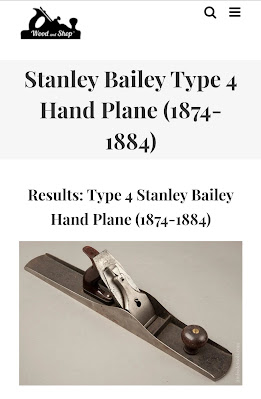Planes
━━━━━━━━━━━━━━━━━━━━
Another Stanley plane
1884 Type 4 No. 7
A treasure inherited
━━━━━━━━━━━━━━━━━━━━
Here we are! Another inherited plane, one that I was a little intimidated by just because of its sheer size. It really wasn't much different than some of the smaller planes I've restored, but I needed to think a few things through.
Inherited
This was another of the myriad of tools I inherited from my former boss's grandfather. This plane was at the bottom of the larger of these two toolboxes, and when I saw it I instantly knew I had a treasure!
What Do We Have Here?
As you probably noticed in the subtitle, this is a Stanley Type 4, Number 7 Jointer plane made sometime between 1874 and 1884.The Condition
Here's how this plane looked when I first took it out of the tool box - really not bad at all!
It had a bit of surface rust, and some chips and sawdust, nearly a century old:
Clean Up and Repair
Clean up started with the body of the plane. The Japanning was in pretty rough shape...
So I put together a case to put the plane in a trash bag to let it soak in paint remover for a couple days. I won't tell you the name of the product but, I let the plane soak for three whole days and when I took it out of the remover, the Japanning was barely affected.
I don't know why I keep trying that specific paint remover, but once I switched to CitriStrip, things got better!
Overnight soaking and voila!
The #7 Jointer, 22"L, 2 3/8"W, 8 1/8lbs, 1869-1970. The jointer is used to true an edge (make it straight) or face (make it flat). This task is usually now done by finger-eatin' machinery, however, there are many de-evolutionists who delight in using these cast iron marvels. Show just how tightly wound you are when you wow your pals with the tightly wound shavings that these planes produce. - Patrick A. Leach, www.SuperTool.com
The Tote
The #7 Jointer, 22"L, 2 3/8"W, 8 1/8lbs, 1869-1970. The jointer is used to true an edge (make it straight) or face (make it flat). This task is usually now done by finger-eatin' machinery, however, there are many de-evolutionists who delight in using these cast iron marvels. Show just how tightly wound you are when you wow your pals with the tightly wound shavings that these planes produce. - Patrick A. Leach, www.SuperTool.com
The tote is the handle at the back of the plane. It takes a lot of stress, so it isn't surprising to see broken totes on older planes. Such was the case with this one...
So I cleaned up the surfaces where the tote had split, and glued them and clamped them together for a day or two (work really can get in the way sometimes!):
It came together pretty good, and I put some pretty good stress on the joint and it seems to be holding up - at least for now!
I took the tote to the 1x30 belt sander for a little shaping and old finish removal...
And I chucked the handle into the drill press for some sanding...
Then it was just a matter of a couple coats of Bombay Mahogany Stain to finish them off! You'll see the finished handles in just a minute.
Painting
Suddenly it was time to paint. I decided to paint the body to match the 1918 Stanley #5 that came with this plane. I painted the 1918 #5 with Rustoleum's Oil Rubbed Bronze, and so it would be for this 1884 #7!I dried the tote, handle and frog on the lower-temperature shop oven. That was mostly because it was -15 degrees F outside and the workshop was a little cool at 56F.
And I cold blued the yoke for the adjustment wheel. Not sure why I chose to do that other than I like the look of cold bluing and I find myself looking for opportunities!
The Little Bits
One of the fun things about restoring a plane is that the prep work can take some time, waiting for paint strippers to do their work, gluing and fixing parts, wire wheeling, staining, etc., but then you get to this point where in an hour or so it's over!
Once you get going on the frog, chip breaker, blade, yoke, screws and pins...it's nearly over. Usually, this part happens for me on a Sunday morning.
And with a little polishing and ta-daaa - it's done!
Done! Fatto! Gjord!
So here are a few beauty shots. I love the textured look the Oil Rubbed Bronze paint gives the bed of the plane. It kin of gives it a bit of dimension.
Not that a 22" #7 plane lacks dimension!
I'm always so tickled with the way these planes turn out. I don't go crazy trying to make them look brand new, but I like fixing them up and paying a bit of tribute to the hard work and life of past generations.
Natural Habitat
And here we are...looking to spy the 1884 #7 in its natural habitat! Because of the sheer size of this plane, I decided to store this one on one of the new shelves in the workshop.
And a closer look in case you missed it!
I hope you enjoyed, and thanks for stopping by! See you next time...





























